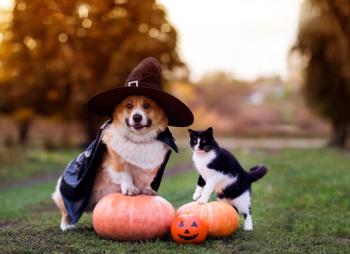
Caring for compromised cattle and euthanasia (Proceedings)
On January 30, 2008 the beef industry was reminded of the importance animal care. The Humane Society of the United States (HSUS) released a video showing abuse of compromised dairy cattle at a California slaughter house.
On January 30, 2008 the beef industry was reminded of the importance animal care. The Humane Society of the United States (HSUS) released a video showing abuse of compromised dairy cattle at a California slaughter house. In addition to abuse of compromised dairy cattle, it was clear that these compromised dairy cattle had entered the food chain. In response to the down dairy cattle entering the food chain form this plant, the USDA initiated a recall of at least 143 million pounds of ground beef associated with the meat processor. Though dairy cattle were depicted in the HSUS video, consumers often do not differentiate between beef and dairy cattle and the firestorm within the media left the beef industry with a black eye. One of the main customers of the plant was the USDA school lunch program. This case has been a rallying point for new legislation such as proposition 2 in California. One of the take home messages is that video cameras are as close as the next person with cellular phone.
In 2009, the Iowa Beef Industry Council (IBIC) released a manual entitled "Caring for Compromised Cattle". Images of a helpless animal; whether puppy, kitten, or cow; being abused or neglected will always elicit a strong emotional response. It is therefore critical for beef veterinarians and producers to demonstrate to the public that we are trustworthy caretakers of our animals. This care should be standard for all animals on the operation, but it is crucial that animals sent to market be carefully evaluated for fitness for marketing. Once the animal leaves the operation, you cannot assume that it will receive the same quality of care that it was given previously. For example, an animal that is compromised but not down, may not successfully handle the strain of marketing and become a downer during transit or after arrival. Animals entering the marketing chain are typically subjected to stressful events that include being transported to market, spending a day or more at an auction market, mixing with other cattle, and traversing a variety of surfaces that may provide less than ideal footing. Additionally, animal handlers in these facilities may not have the experience or caring attitude to manage compromised cattle. Regardless of who is at fault, when the poor handling of one of these animals is broadcast the entire beef industry suffers. Therefore, each individual beef operation needs to assure that they do not market compromised cattle.
Most beef cattle that are marketed are in excellent health and physical condition. However, a small percentage of cattle are marketed with health conditions that cause them to be compromised and unfit for normal marketing channels. Many of these compromised animals are condemned at slaughter and this ultimately produces a negative effect on prices. As demonstrated by the Hallmark incident, the financial return for marketing compromised cattle is not worth the potential scandal. It is more beneficial for the industry to humanely euthanize these animals on the premise and demonstrate good animal care and husbandry practices within the industry. There are some auction markets that are now chaining and locking their gates at night to prevent compromised cattle from being left at auction barn.
In 2010 the AVMA revised the veterinarian's oath to reflect and increased attention on animal welfare. Veterinarians have a responsibility to be an advocate for good animal welfare for the cattle that are under their care. We need to become more assertive towards our clients when making recommendations regarding the best welfare of the animal. We expect when we make a diagnosis and prescribe a treatment that the cattle grower will follow our directions. We should have the same attitude towards welfare decisions as we have for treatment protocols.
Veterinarians need to evaluate 11 factors to determine if cattle are capable of being marketed.
1. Body condition – Thin animals should not be marketed
2. Exhaustion/dehydration – Should not be marketed
3. Lameness – Cattle that cannot rise and walk on their own should not be marketed
4. Bone fracture – Limb or spinal fracture should be euthanized
5. Fever - >104°F should not be marketed
6. Cancer eye – Severe cancer eye should be euthanized
7. Blindness – Blind cattle should be euthanized
8. Pregnancy/Calving – Cattle within 48 hours of calving should not be marketed
9. Uterine prolapsed – Cattle with uterine prolapsed should not be marketed
10. Congestive heart failure – Cattle with heart failure should be euthanized
11. Nervous disorder – Cattle with a nervous disorder should be euthanized
Cattle with less severe problems may need to be marketed with special provisions. If possible they should be taken directly to a processor instead of marketing through a livestock market. Extra bedding and segregation of animals may be necessary. All animals should be evaluated prior to leaving the operation. Animals that are being sold as chronics need to be carefully reviewed for the drug withdrawal clearance and their ability to be a viable candidate to enter marketing channels. Guidelines established by the Iowa Beef Industry Council are a vital resource when choosing to market chronic animals. Before marketing an animal, especially a compromised animal, ask yourself: "Is the meat from this animal something I would want my family to consume?"; "Is it humane to market this animal?"; "Would the public's perception of this animal be positive?" If you cannot answer "yes" to each of these questions, then you must reconsider marketing the animal. Consumer surveys have identified that one priority for consumers is knowing that producers care. Caring for compromised cattle properly on the farm and not allowing compromised cattle to enter marketing channels is an important component to demonstrate to consumers that we care about our livestock.
Cattle that do not meet requirements to be able to market should be euthanized on farm. Euthanasia is derived from Greek word meaning "good death". Euthanasia is accomplished when death occurs without pain or distress. Euthanasia protocols for cattle mush induce immediate loss of consciousness followed by respiratory and cardiac arrest. Traditionally, veterinarians relied on an overdose of a barbiturate for most euthanasia. However, controlled substance regulations have led many veterinarians to seek alternate means to euthanize cattle. Additionally, there are some rendering companies that will not accept livestock that have been euthanized with a barbiturate because of tissue residue problems. Another problem is death loss if scavenges (eagles) feed on unburied carcasses.
Exsanguination is routinely mentioned as a method for euthanasia. However, the animal must be completely anesthetized prior to exsanguination which would require a controlled substance. The use of potassium chloride is the same as exsanguination. KCl can be used a secondary step for euthanasia but the animal must be completely anesthetized before KCl is administered.
For on farm euthanasia of cattle a gunshot or captive bolt is the most practical. A properly administered shot renders the animal unconscious and in many cases is sufficient to euthanize the animal. If necessary a secondary step such as exsanguination or KCl can be used. For young calves a .22 caliber is usually sufficient. Older animals may require a larger caliber such as a 9mm or .357. Always use solid point bullets, hollow points may fragment and not reach the brain stem. 20 gauge or larger shotguns with Number 6 birdshot can also be used successfully. The landmark for gunshot or captive bolt is an X drawn from lateral canthus of the eye to the opposite horn base (NOT between the eyes).
Manually applied blunt trauma, injection of a chemical substance or electrocution with 120 volt cord are UNACCEPTABLE methods to euthanize cattle.
Newsletter
From exam room tips to practice management insights, get trusted veterinary news delivered straight to your inbox—subscribe to dvm360.






